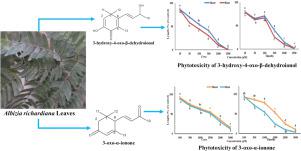Environmental Technology & Innovation ( IF 6.7 ) Pub Date : 2021-07-08 , DOI: 10.1016/j.eti.2021.101779 Kawsar Hossen 1, 2 , Arihiro Iwasaki 3 , Kiyotake Suenaga 3 , Hisashi Kato-Noguchi 1, 2

|
To protect our environment from the toxic effect of herbicides, it is necessary to reduce the application of synthetic herbicides for controlling weeds in crop fields as well as to increase the use of natural herbicides produced from plant sources. Phytotoxic compounds obtained from plant species have gained attention as an alternate biological method for managing weeds. Albizia richardiana was previously reported to contain a number of phytotoxic substances. Therefore, we carried out this study to investigate more allelopathic substances in Albizia richardiana leaves. Aqueous methanol extracts of Albizia richardiana leaves were significantly inhabited the seedling growth of the two test species (alfalfa and timothy) in a concentration-dependent manner. The two most active substances were separated through different chromatographic steps and characterized as a novel compound 3-hydroxy-4-oxo--dehydroionol [(E)-6-hydroxy-3-(3-hydroxybut-1-en-1-yl)-2,4,4-trimethylcyclohexa-2,5-dien-1-one], and compound 3-oxo--ionone [3,5,5-trimethyl-4-(3-oxo-1-butenyl)-2-cyclohexen-1-one]. The novel compound 3-hydroxy-4-oxo--dehydroionol showed relatively stronger growth inhibitory potential compare to the compound 3-oxo--ionone and significantly restricted the seedling growth of crees and timothy. The required concentration for a 50% reduction in the growth ( values) of the cress and timothy seedlings varied from 63.78 to 141.61 M for 3-hydroxy-4-oxo--dehydroionol and 1059.60 to 1616.10 M for 3-oxo--ionone. The results indicate that these two allelopathic compounds may be responsible for the phytotoxicity of Albizia richardiana leaves.
中文翻译:

新型化合物 3-hydroxy-4-oxo- 的植物毒性-脱氢紫罗兰醇和化合物3-氧代--来自Albizia richardiana (Voigt.) King & Prain 的紫罗兰酮
为了保护我们的环境免受除草剂的毒性影响,有必要减少使用合成除草剂来控制农田杂草,并增加使用植物来源的天然除草剂。从植物物种中提取的植物毒性化合物作为管理杂草的替代生物方法受到关注。据报道,合欢花含有多种植物毒性物质。因此,我们开展了这项研究,以研究合欢叶中更多的化感物质。合欢的甲醇水溶液提取物叶子以浓度依赖的方式显着地栖息在两个测试物种(苜蓿和梯牧草)的幼苗生长中。两种最活跃的物质通过不同的色谱步骤分离,并表征为一种新型化合物 3-hydroxy-4-oxo--脱氢紫罗兰醇[( E )-6-羟基-3-(3-羟基丁-1-烯-1-基)-2,4,4-三甲基环己-2,5-二烯-1-酮]和化合物3- oxo--紫罗兰酮 [3,5,5-trimethyl-4-(3-oxo-1-butenyl)-2-cyclohexen-1-one]。新型化合物 3-hydroxy-4-oxo--与化合物 3-氧代-相比,脱氢紫罗兰醇显示出相对更强的生长抑制潜力-紫罗兰酮并显着限制了 crees 和 Timothy 的幼苗生长。使生长减少 50% 所需的浓度 ( 水芹和蒂莫西幼苗的值)从 63.78 到 141.61 不等 M 代表 3-hydroxy-4-oxo--脱氢紫罗兰醇和 1059.60 至 1616.10 M 代表 3-oxo--紫罗兰酮。结果表明,这两种化感化合物可能是合欢叶植物毒性的原因。











































 京公网安备 11010802027423号
京公网安备 11010802027423号